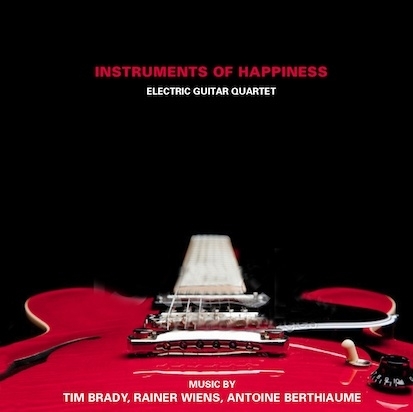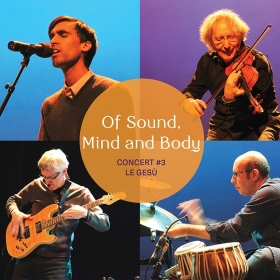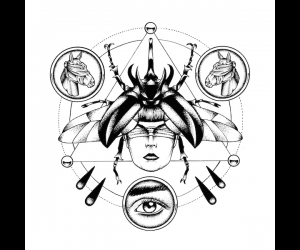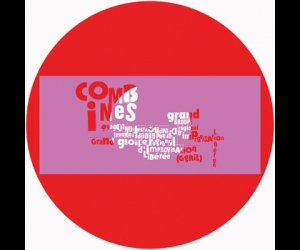
For over two decades Tim Brady has been creating orchestral works written specifically for ensembles of electric guitars. He is also a master guitarist, occasionally spotted running his fingers over a fretboard in less formal settings. His latest studio CD of notated material collects three works by three different composers, while the stellar improvising trio Of Sound, Mind and Body, to which Brady belongs, has released a recording of a live concert.
Instruments of Happiness of course refers to guitars (as in “who can be unhappy while holding a guitar?”), although there is a wider range of emotions conveyed on the disc than the one declared in the title. About three quarters of the sixty-eight minutes is taken up by two distinct versions of Brady’s The Same River Twice: Symphony #5.0, one for guitar quartet, the other for solo axe. Rounding out the disc are Antoine Berthiaume’s Fungi and Brady’s remix of Rainer Weins’ What is Time? Brady and Berthiaume are joined by Gary Schwartz and Michel Héroux on the quartet tracks.
Some movements from The Same River, such as “Float,” recall guitar quartets such as Fred Frith’s or Quebec’s Les 4 Guitaristes de l’Apocalypso-Bar, but the work is more informed by modern composition than by free improvisation. This lends control and clarity to the proceedings—for example, when Steve Reich-like rapid-fire arpeggios morph over time, or when beats are counted out loud, similarly to Philip Glass’ Einstein on the Beach. There’s one point during the movement named “A Somewhat Eccentric Waltz” that’s reminiscent of the narrator’s comments in Paul Dolden’s Who Has the Biggest Sound?, as Brady demands that the music stop, and while it’s paused, makes declarations concerning it.
Texturally, the CD showcases the guitar’s versatility. Fast-picked tremolos emerge from barely audible beds to foreground swells. Burn uses arpeggios as background for highly compressed solo lines imitating a bowed violin. Freeze begins with highly processed guitar that sounds more like an organ. Distorted noise-bursts or pick-scrapes last just a few instants—accents rather than main events.
Berthiaume’s Fungi is the most traditional-sounding work, using minimal processing to imply a classical string quartet that happens to be played on guitars. Wein’s piece lies in a different sonic world, with effects and processing replaced by physical guitar preparations,


and carefully composed interlocking lines replaced by Zen-inspired sparseness. In electroacoustic fashion, objects rattle off the strings and bell-like chimes remind one of how time used to be clocked.
A dense swirl of guitar electronics, a voice emitting various sibilant syllables and a sequence of violin squeals announce the arrival of Of Sound, Mind and Body with guest vocalist Gabriel Dharmoo [profiled in this issue]. Brady uses many of the same guitar techniques mentioned above, but in this context they complement the group sound more often than they hold the primary focus. Dharmoo vocalizes with an imagination and detail that betray deep studies of composition, improvisation, and ethnomusicology. Helmut Lipsky is the violinist in the trio, and Shawn Mativetsky is the tabla percussionist.
The mix of instruments suggests rock, Western classical, and Indian traditions, hinting at the breadth of styles traversed across seven tracks. While Mativetsky and Dharmoo are featured on Rue Bleury, which has the feel of an Indian raga, there is a constant shifting of terrain throughout. With a very high level of musicianship and sensitive listening, this will surely be one of the year’s best improvisatory workouts.


